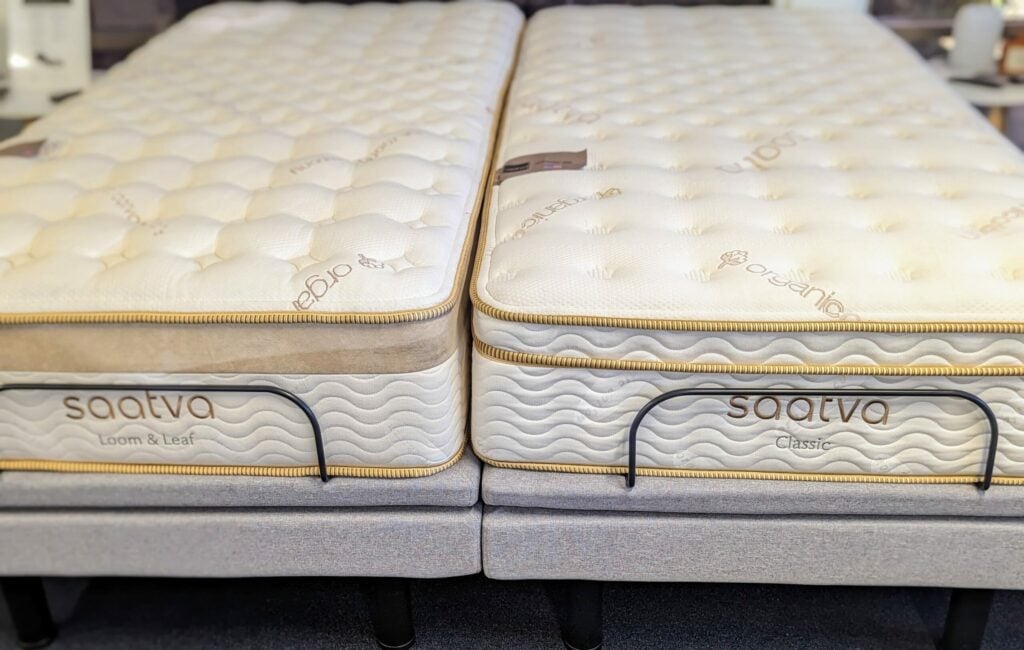Using Your Bed for Protection During Hurricane Hilary: A Step-by-Step Guide
As Hurricane Hilary approaches Southern California, with an expected landfall on August 20, 2023, residents are urged to prepare for the impending storm. With winds exceeding 100 miles per hour and the potential for torrential rainfall, it’s essential to have a plan in place to stay safe. One often-overlooked option is using your bed as a protective barrier. Here’s how to do it:
Choose a Safe Room: Identify a room in your home that is least exposed to the storm. This should be an interior room with no windows, such as a bathroom, closet, or hallway. Avoid rooms with large windows or glass doors, as they can shatter during the storm.
Prepare the Room: Remove any loose items, such as picture frames or vases, which could become projectiles during the hurricane. Secure heavy furniture to the walls, if possible, to prevent it from tipping over.
Move Your Bed: If the room you’ve chosen is large enough, move your bed into the room. If not, you can use your mattresses or box springs. Position your bed, mattress, or box spring against the walls, creating a fort-like structure. This will provide a protective barrier against flying debris and possible structural damage during the hurricane.
Gather Supplies: Inside your designated safe room, store a supply of water, non-perishable food, medications, flashlights, and a battery-powered or hand-crank radio. Keep these essentials in a sturdy container, so you can quickly access them during the storm.
Stay Updated: Tune into local news and weather stations for the latest updates on Hurricane Hilary’s path and strength. Follow the instructions of local authorities, and be ready to evacuate if necessary.
Seek Shelter: When the storm hits, take cover in your designated safe room behind your makeshift bed barrier. Stay there until the storm has passed and it’s safe to emerge. Hurricanes can last several hours, so be prepared to stay in your shelter for an extended period.
Remain Calm: Hurricanes can be frightening, but it’s important to stay calm. Keep a battery-powered or hand-crank radio nearby to stay updated on the storm’s progress and any emergency announcements.
Assess Damage: After the hurricane has passed and it’s safe to leave your shelter, carefully inspect your home for damage. Look for signs of structural damage, gas leaks, or water leaks. If you suspect any gas leaks, turn off the main gas valve and contact emergency services immediately.
Document Damage: Take photos and videos of any damage to your property. This documentation will be essential for insurance claims.
Follow Local Instructions: In the aftermath of Hurricane Hilary, adhere to any directives from local authorities regarding re-entry into evacuated areas, debris removal, and safety precautions.
Remember, your bed, mattresses, or heavy blankets can provide a protective barrier during a hurricane, but they are not a substitute for proper hurricane preparedness. Always have a comprehensive emergency plan in place, including a designated safe room and essential supplies. Stay informed, follow local guidelines, and prioritize your safety and the safety of your loved ones during Hurricane Hilary and any future storms.

Surviving Hurricane Hilary: Strategies for Sleeping Safely Without Power
As Hurricane Hilary continues its advance toward Southern California, residents should be prepared for the likelihood of power outages. Navigating these situations can be daunting, especially when trying to get some sleep amid the chaos. Here, we offer some strategies for ensuring a restful night’s sleep during power outages caused by Hurricane Hilary.
Create a Safe Space: Before attempting to sleep, ensure that you have a secure place to rest. Choose a room with no windows or the smallest windows possible, such as an interior room, hallway, or bathroom. These areas are less likely to be impacted by flying debris and will offer a quieter environment for sleep.
Use Portable Lighting: As the power may be out, have a flashlight or battery-operated lantern ready for use. Avoid using candles, as they can pose a fire hazard. Keep your lighting source within arm’s reach in case you need it during the night.
Stay Cool: With the power out, your home’s air conditioning will not be functional. To keep cool, wear lightweight, breathable clothing and use battery-operated fans if available. If your home becomes too hot, dampen a washcloth with cool water and place it on your forehead or the back of your neck to help lower your body temperature.
Avoid Overexertion: During a hurricane, it is essential to conserve energy. Overexertion can lead to excessive sweating and dehydration, making it harder to fall asleep. Instead, focus on staying calm and relaxed.
Limit Noise Disruptions: Hurricanes can be noisy, with loud winds, rain, and thunder. To help drown out the noise, consider using earplugs or noise-canceling headphones. These can help create a more serene environment for sleep.
Minimize Light Exposure: If the storm occurs during the day, cover windows with blankets or towels to block out light and create a darker environment conducive to sleep.
Stay Informed: Keep a battery-powered or hand-crank radio nearby to monitor the progress of Hurricane Hilary and any updates from local authorities. Set the volume low enough to hear important announcements but not so loud that it disrupts your sleep.
Create Comfort: Make your sleeping area as comfortable as possible. Use pillows, blankets, or even your bed’s mattress to create a cozy environment. Consider bringing your favorite comfort items, like a book or stuffed animal, to help you relax.
Practice Relaxation Techniques: To ease your mind and prepare for sleep, practice deep breathing or progressive muscle relaxation. These techniques can help reduce stress and promote restful sleep.
Prioritize Safety: While getting adequate sleep is essential, your safety should always be your top priority. If the hurricane’s intensity increases or your home becomes unsafe, be prepared to move to a safer location, even if it means sacrificing some sleep.
The arrival of Hurricane Hilary in Southern California requires residents to take safety precautions seriously. Following these guidelines can help you achieve a better night’s sleep during power outages caused by the storm. Remember, staying informed, calm, and safe are of the utmost importance during any hurricane event.

Using Your Bed for Protection During Hurricane Hilary: A Step-by-Step Guide
As Hurricane Hilary approaches Southern California, with an expected landfall on August 20, 2023, residents are urged to prepare for the impending storm. With winds exceeding 100 miles per hour and the potential for torrential rainfall, it’s essential to have a plan in place to stay safe. One often-overlooked option is using your bed as a protective barrier. Here’s how to do it:
Choose a Safe Room: Identify a room in your home that is least exposed to the storm. This should be an interior room with no windows, such as a bathroom, closet, or hallway. Avoid rooms with large windows or glass doors, as they can shatter during the storm.
Prepare the Room: Remove any loose items, such as picture frames or vases, which could become projectiles during the hurricane. Secure heavy furniture to the walls, if possible, to prevent it from tipping over.
Move Your Bed: If the room you’ve chosen is large enough, move your bed into the room. If not, you can use your mattresses or box springs. Position your bed, mattress, or box spring against the walls, creating a fort-like structure. This will provide a protective barrier against flying debris and possible structural damage during the hurricane.
Gather Supplies: Inside your designated safe room, store a supply of water, non-perishable food, medications, flashlights, and a battery-powered or hand-crank radio. Keep these essentials in a sturdy container, so you can quickly access them during the storm.
Stay Updated: Tune into local news and weather stations for the latest updates on Hurricane Hilary’s path and strength. Follow the instructions of local authorities, and be ready to evacuate if necessary.
Seek Shelter: When the storm hits, take cover in your designated safe room behind your makeshift bed barrier. Stay there until the storm has passed and it’s safe to emerge. Hurricanes can last several hours, so be prepared to stay in your shelter for an extended period.
Remain Calm: Hurricanes can be frightening, but it’s important to stay calm. Keep a battery-powered or hand-crank radio nearby to stay updated on the storm’s progress and any emergency announcements.
Assess Damage: After the hurricane has passed and it’s safe to leave your shelter, carefully inspect your home for damage. Look for signs of structural damage, gas leaks, or water leaks. If you suspect any gas leaks, turn off the main gas valve and contact emergency services immediately.
Document Damage: Take photos and videos of any damage to your property. This documentation will be essential for insurance claims.
Follow Local Instructions: In the aftermath of Hurricane Hilary, adhere to any directives from local authorities regarding re-entry into evacuated areas, debris removal, and safety precautions.
Remember, your bed, mattresses, or heavy blankets can provide a protective barrier during a hurricane, but they are not a substitute for proper hurricane preparedness. Always have a comprehensive emergency plan in place, including a designated safe room and essential supplies. Stay informed, follow local guidelines, and prioritize your safety and the safety of your loved ones during Hurricane Hilary and any future storms.

Surviving Hurricane Hilary: Strategies for Sleeping Safely Without Power
As Hurricane Hilary continues its advance toward Southern California, residents should be prepared for the likelihood of power outages. Navigating these situations can be daunting, especially when trying to get some sleep amid the chaos. Here, we offer some strategies for ensuring a restful night’s sleep during power outages caused by Hurricane Hilary.
Create a Safe Space: Before attempting to sleep, ensure that you have a secure place to rest. Choose a room with no windows or the smallest windows possible, such as an interior room, hallway, or bathroom. These areas are less likely to be impacted by flying debris and will offer a quieter environment for sleep.
Use Portable Lighting: As the power may be out, have a flashlight or battery-operated lantern ready for use. Avoid using candles, as they can pose a fire hazard. Keep your lighting source within arm’s reach in case you need it during the night.
Stay Cool: With the power out, your home’s air conditioning will not be functional. To keep cool, wear lightweight, breathable clothing and use battery-operated fans if available. If your home becomes too hot, dampen a washcloth with cool water and place it on your forehead or the back of your neck to help lower your body temperature.
Avoid Overexertion: During a hurricane, it is essential to conserve energy. Overexertion can lead to excessive sweating and dehydration, making it harder to fall asleep. Instead, focus on staying calm and relaxed.
Limit Noise Disruptions: Hurricanes can be noisy, with loud winds, rain, and thunder. To help drown out the noise, consider using earplugs or noise-canceling headphones. These can help create a more serene environment for sleep.
Minimize Light Exposure: If the storm occurs during the day, cover windows with blankets or towels to block out light and create a darker environment conducive to sleep.
Stay Informed: Keep a battery-powered or hand-crank radio nearby to monitor the progress of Hurricane Hilary and any updates from local authorities. Set the volume low enough to hear important announcements but not so loud that it disrupts your sleep.
Create Comfort: Make your sleeping area as comfortable as possible. Use pillows, blankets, or even your bed’s mattress to create a cozy environment. Consider bringing your favorite comfort items, like a book or stuffed animal, to help you relax.
Practice Relaxation Techniques: To ease your mind and prepare for sleep, practice deep breathing or progressive muscle relaxation. These techniques can help reduce stress and promote restful sleep.
Prioritize Safety: While getting adequate sleep is essential, your safety should always be your top priority. If the hurricane’s intensity increases or your home becomes unsafe, be prepared to move to a safer location, even if it means sacrificing some sleep.
The arrival of Hurricane Hilary in Southern California requires residents to take safety precautions seriously. Following these guidelines can help you achieve a better night’s sleep during power outages caused by the storm. Remember, staying informed, calm, and safe are of the utmost importance during any hurricane event.

Finding Solace in the Bedroom: Activities to Pass Time During Power Outages in Hurricane Hilary
As Hurricane Hilary bears down on Southern California, it is vital for residents to stay indoors, preferably in a safe room like the bedroom, where they can ride out the storm and stay away from potential hazards. Power outages are likely during the storm, but there are still plenty of activities to pass the time and stay entertained in your bedroom. Here are some suggestions:
Read a Book: If there’s enough natural light or you have a battery-powered lantern, take the opportunity to immerse yourself in a good book. Whether it’s fiction or non-fiction, reading can provide an escape from the chaos of the hurricane.
Write in a Journal: Document your experiences during the hurricane. Writing about your thoughts and feelings can be a therapeutic way to cope with the stress of the situation. You might also consider writing letters to friends and family members, even if you can’t send them right away.
Listen to Battery-Powered Radio: Tune into local news and weather updates to stay informed about the storm’s progress and any emergency instructions. Some radios also come equipped with built-in speakers, allowing you to listen to music or other radio programs.
Play Card or Board Games: If you have family members or roommates with you, a deck of cards or board games can provide hours of entertainment and help pass the time.
Solve Puzzles: Crossword puzzles, Sudoku, or jigsaw puzzles can be a great way to keep your mind engaged and focused away from the storm outside.
Meditation and Deep Breathing: Practice deep breathing or meditation to help calm your nerves and reduce stress. These exercises can help you feel more relaxed and grounded during the storm.
Stretch or Do Light Exercises: Physical activity can help relieve tension and keep you feeling more comfortable while confined indoors. Simple stretches or yoga poses can help maintain your flexibility and circulation.
Organize Your Room: While you’re stuck in your bedroom, you might as well make the best of it. Organize your belongings, declutter, and rearrange your space. You’ll be surprised how much better a tidy room can make you feel.
Engage in Creative Activities: Drawing, painting, or crafting can be an excellent way to pass the time and express your emotions. Even if you’re not artistically inclined, doodling or coloring can be calming.
Plan for the Future: Use this time to reflect on your goals and make plans for the future. Whether it’s jotting down ideas for a home renovation, planning a vacation, or setting career goals, having something to look forward to can be uplifting during a challenging time.
Conserve Your Energy: Remember that during a hurricane, conserving your energy is essential. If you find yourself feeling tired, don’t hesitate to lie down and get some rest.
Staying entertained without power during Hurricane Hilary may seem challenging, but with a little creativity and resourcefulness, you can find plenty of activities to pass the time and reduce stress. Remember to stay informed about the hurricane’s status, follow local authorities’ recommendations, and prioritize your safety throughout the storm.
Southern California, located along the western coast of the United States, typically experiences relatively mild weather compared to other regions. It is generally sheltered from the full force of hurricanes and tropical cyclones due to cooler ocean temperatures and prevailing wind patterns. However, there have been some exceptions. Here, we detail some of the most devastating tropical systems that have impacted Southern California:
Hurricane Kathleen (1976): Kathleen remains one of the most significant hurricanes to hit Southern California. The storm brought strong winds and heavy rainfall, causing severe flooding. The hurricane claimed six lives, destroyed hundreds of homes, and resulted in over $160 million in damages.
Tropical Storm Nora (1997): Although it had weakened from a Category 1 hurricane to a tropical storm by the time it made landfall in Southern California, Nora still caused considerable damage. The storm’s remnants brought heavy rainfall to the region, resulting in flooding, landslides, and significant property damage. Overall, Nora caused three fatalities and over $100 million in damages.
Tropical Storm Lidia (1981): Lidia’s remnants brought heavy rainfall to Southern California, causing flash flooding and mudslides. The storm caused three fatalities and millions of dollars in damages.
Tropical Storm Octave (1983): Although Octave did not directly impact Southern California, its remnants caused severe flooding in parts of the state. The storm claimed several lives, destroyed hundreds of homes, and caused millions of dollars in damages.
Hurricane Dolores (2015): Dolores did not make direct landfall in Southern California, but its remnants brought heavy rainfall to the region. The rain caused flash flooding, leading to property damage and transportation disruptions.
It’s essential to note that while these storms have been among the most significant to impact Southern California, they are rare events. The region typically sees less tropical storm activity than other parts of the United States, such as the Gulf Coast or Southeast. However, it’s always crucial for residents to stay informed and prepared for any potential storms, especially during hurricane season.
Finding Solace in the Bedroom: Activities to Pass Time During Power Outages in Hurricane Hilary
As Hurricane Hilary bears down on Southern California, it is vital for residents to stay indoors, preferably in a safe room like the bedroom, where they can ride out the storm and stay away from potential hazards. Power outages are likely during the storm, but there are still plenty of activities to pass the time and stay entertained in your bedroom. Here are some suggestions:
Read a Book: If there’s enough natural light or you have a battery-powered lantern, take the opportunity to immerse yourself in a good book. Whether it’s fiction or non-fiction, reading can provide an escape from the chaos of the hurricane.
Write in a Journal: Document your experiences during the hurricane. Writing about your thoughts and feelings can be a therapeutic way to cope with the stress of the situation. You might also consider writing letters to friends and family members, even if you can’t send them right away.
Listen to Battery-Powered Radio: Tune into local news and weather updates to stay informed about the storm’s progress and any emergency instructions. Some radios also come equipped with built-in speakers, allowing you to listen to music or other radio programs.
Play Card or Board Games: If you have family members or roommates with you, a deck of cards or board games can provide hours of entertainment and help pass the time.
Solve Puzzles: Crossword puzzles, Sudoku, or jigsaw puzzles can be a great way to keep your mind engaged and focused away from the storm outside.
Meditation and Deep Breathing: Practice deep breathing or meditation to help calm your nerves and reduce stress. These exercises can help you feel more relaxed and grounded during the storm.
Stretch or Do Light Exercises: Physical activity can help relieve tension and keep you feeling more comfortable while confined indoors. Simple stretches or yoga poses can help maintain your flexibility and circulation.
Organize Your Room: While you’re stuck in your bedroom, you might as well make the best of it. Organize your belongings, declutter, and rearrange your space. You’ll be surprised how much better a tidy room can make you feel.
Engage in Creative Activities: Drawing, painting, or crafting can be an excellent way to pass the time and express your emotions. Even if you’re not artistically inclined, doodling or coloring can be calming.
Plan for the Future: Use this time to reflect on your goals and make plans for the future. Whether it’s jotting down ideas for a home renovation, planning a vacation, or setting career goals, having something to look forward to can be uplifting during a challenging time.
Conserve Your Energy: Remember that during a hurricane, conserving your energy is essential. If you find yourself feeling tired, don’t hesitate to lie down and get some rest.
Staying entertained without power during Hurricane Hilary may seem challenging, but with a little creativity and resourcefulness, you can find plenty of activities to pass the time and reduce stress. Remember to stay informed about the hurricane’s status, follow local authorities’ recommendations, and prioritize your safety throughout the storm.
Southern California, located along the western coast of the United States, typically experiences relatively mild weather compared to other regions. It is generally sheltered from the full force of hurricanes and tropical cyclones due to cooler ocean temperatures and prevailing wind patterns. However, there have been some exceptions. Here, we detail some of the most devastating tropical systems that have impacted Southern California:
Hurricane Kathleen (1976): Kathleen remains one of the most significant hurricanes to hit Southern California. The storm brought strong winds and heavy rainfall, causing severe flooding. The hurricane claimed six lives, destroyed hundreds of homes, and resulted in over $160 million in damages.
Tropical Storm Nora (1997): Although it had weakened from a Category 1 hurricane to a tropical storm by the time it made landfall in Southern California, Nora still caused considerable damage. The storm’s remnants brought heavy rainfall to the region, resulting in flooding, landslides, and significant property damage. Overall, Nora caused three fatalities and over $100 million in damages.
Tropical Storm Lidia (1981): Lidia’s remnants brought heavy rainfall to Southern California, causing flash flooding and mudslides. The storm caused three fatalities and millions of dollars in damages.
Tropical Storm Octave (1983): Although Octave did not directly impact Southern California, its remnants caused severe flooding in parts of the state. The storm claimed several lives, destroyed hundreds of homes, and caused millions of dollars in damages.
Hurricane Dolores (2015): Dolores did not make direct landfall in Southern California, but its remnants brought heavy rainfall to the region. The rain caused flash flooding, leading to property damage and transportation disruptions.
It’s essential to note that while these storms have been among the most significant to impact Southern California, they are rare events. The region typically sees less tropical storm activity than other parts of the United States, such as the Gulf Coast or Southeast. However, it’s always crucial for residents to stay informed and prepared for any potential storms, especially during hurricane season.


















